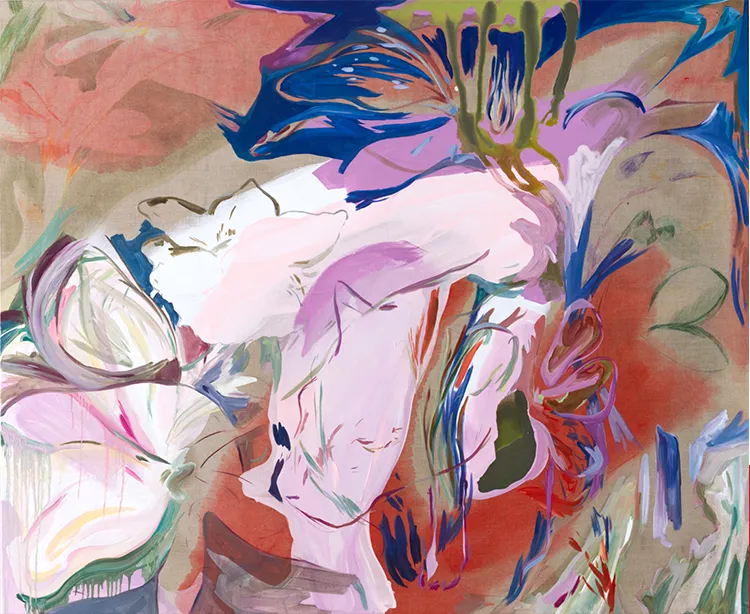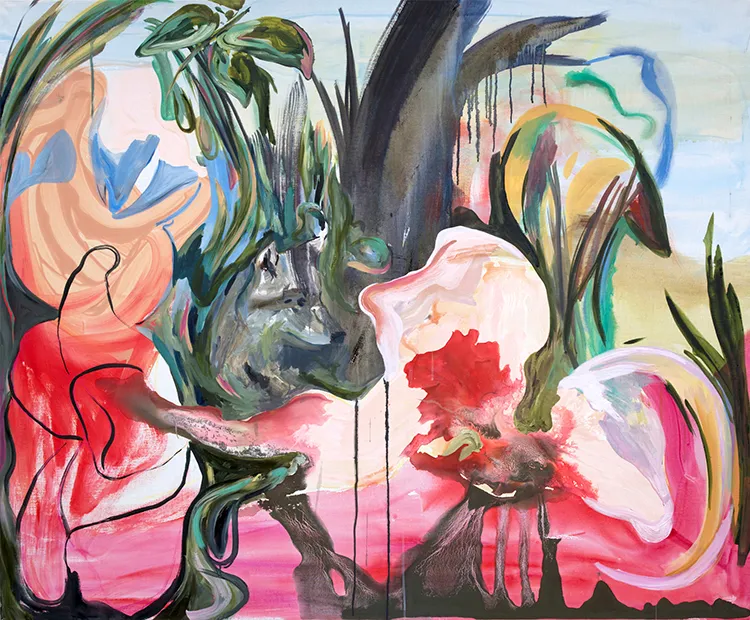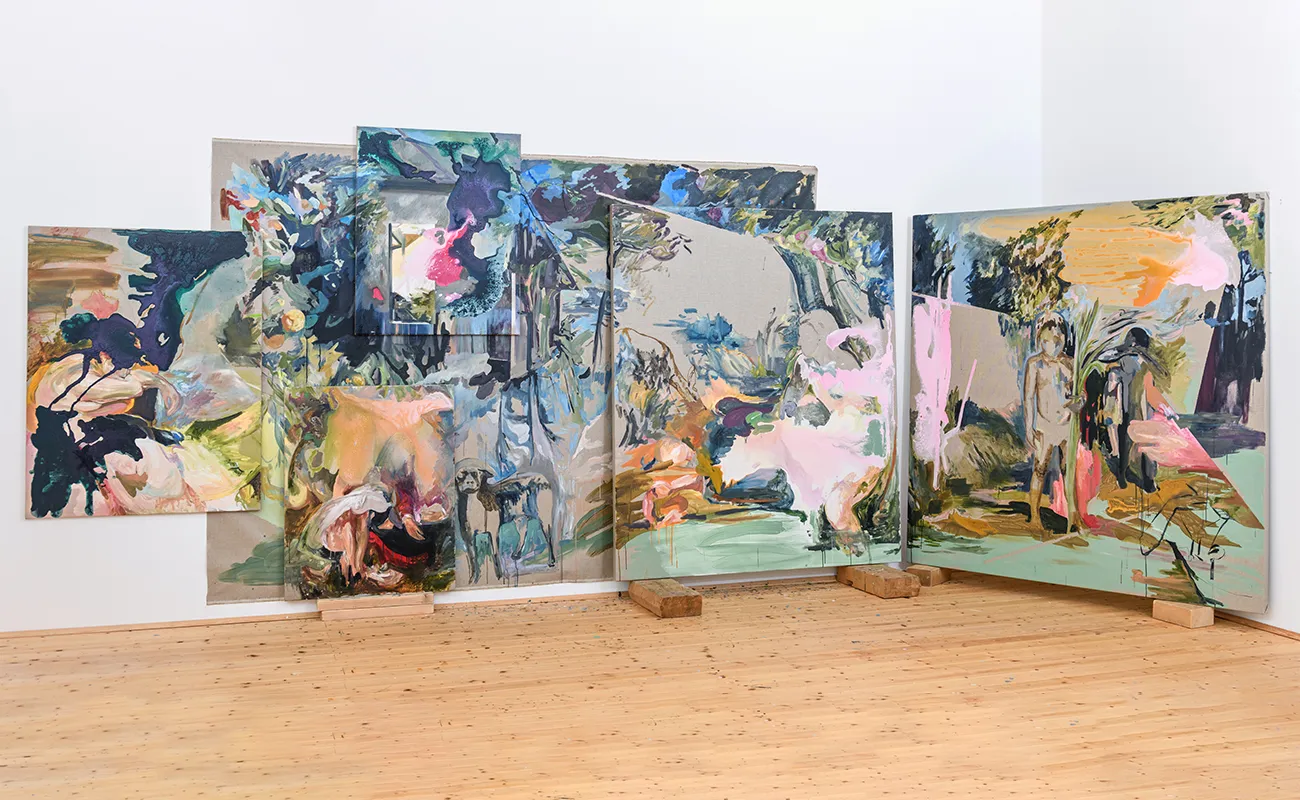“Finding connection in different ways is central to my work. It is about relationships and the unavoidable entanglement of all life.”
A House of Stories: Inspirations Rooted in the Past
Elisabeth Wedenig works in an environment rich with memories and stories. After completing her art studies, she moved to her grandparents’ house in the countryside, a place that became a significant wellspring of inspiration. The house, with its remnants offered Elisabeth unique resources. The practice of integrating fragments of the past into her work reflects her deep connection to the cyclical nature of life, mirroring the ever-changing landscape surrounding her. The rural setting, with its seasonal transformations, provides a constant source of inspiration, infusing her art with the vitality and flux of the natural world.
Nature is not merely a backdrop for Elisabeth; it is a dynamic force that shapes her creative process. The growth and decay, the recurring transformations, and the intricate connections within nature all find their way into her artwork. Her ability to absorb and reinterpret these elements speaks to a profound sensitivity to her surroundings. Elisabeth’s art captures more than just the physical appearance of nature; it delves into the essence of its ever-changing existence, exploring how everything is interconnected and constantly evolving.

Elisabeth Wedenig: Creating in Harmony with Nature
Elisabeth Wedenig’s workspace is an extension of her artistic philosophy. Her studio, affectionately named “Haaskeusche” or “rabbit cottage,” is a wooden cube that epitomizes her harmonious relationship with nature. The studio’s design, featuring a large glass door on the north side, seamlessly integrates the surrounding environment into the creative space. This connection allows Elisabeth to observe the changing seasons and draw profound inspiration from the natural world. Light, color, and nature are essential elements in her work, and her studio is meticulously organized to facilitate her creative process.
Within this sanctuary, various objects hold personal significance, creating a space imbued with memory and meaning. An old armchair from her grandfather, despite its unattractive appearance, serves as a cherished place for reflection. The chair’s comfort provides a perfect spot for contemplation, enriching Elisabeth’s creative flow. The mobility of objects in her studio, many of which are on wheels, allows her to rearrange the space as needed for different stages of her work. This flexibility is crucial, enabling her to view her work from multiple perspectives and adapt her process accordingly.

Flexible Process: The Interplay of Abstraction and Figuration
Elisabeth Wedenig’s artistic style is a continuous gathering of fragments from her external observations and internal experiences. Her fascination with the painting process itself is evident in her work, characterized by an intuitive and evolving approach. Primarily using oils, acrylics, and colored pencils on various surfaces, she combines abstraction and figuration to create a sense of in-between or togetherness. This dynamic process involves choosing materials that often remain partially visible in the final piece, drawing directly on raw canvas, and applying fluid paint that soaks into the fabric. Layers of transparent and opaque surfaces blend, transforming the painting in ways that sometimes make her initial intentions unrecognizable.
Elisabeth’s approach is flexible, allowing her to adapt and evolve as the artwork progresses. Drawings often become integral parts of her paintings, though some stand alone as independent works. Recently, she has explored contrasting large, intensely colored paintings with delicate, intimate colored pencil drawings. Inspired by Baroque compositions, particularly those of Rubens, her latest series centers on lush vegetation. This juxtaposition of scale and detail creates a rich visual dialogue, capturing the viewer’s attention and inviting them to delve deeper into the layers of meaning.

Working in Series: Versions of Reality
Elisabeth predominantly works in series, where individual pieces interact with each other, showcasing her interest in the flexibility of perception. This approach allows her to explore how artworks can change and influence each other when viewed together, offering a deeper understanding of her creative vision. “Aus dem Raum gefallen” (“Fallen out of Space”) stands as a pivotal creation within Elisabeth Wedenig’s artistic portfolio. This multipart work features canvases of varying sizes, strategically placed at different heights on a wall, creating a dynamic visual experience. The canvases partially overlap, yet together, they form a cohesive pictorial space. When exhibited collectively, the artwork offers a distinct experience compared to viewing the pieces in isolation, embodying Wedenig’s belief in the fluidity and multiplicity of truth. This philosophical approach underscores that truth is not singular or fixed; rather, it is mutable and adaptable, allowing her artworks to continuously evolve and transform.
During exhibitions, the positioning of each piece is subject to change, enabling them to be viewed independently or in conjunction with others. This adaptability requires a performative intervention, often involving someone to adjust the placement of the canvases. Such an arrangement not only enhances the viewer’s engagement with the artwork but also reflects the notion that perception is influenced by context and relational dynamics. This methodology reinforces the idea that reality and truth are multifaceted and constantly shifting.
Additionally, Wedenig extends the themes explored in “Aus dem Raum gefallen” by translating specific details from her paintings into drawings. This practice allows her to delve into variations of her concepts. The interplay between singularity and togetherness in this work resonates with her artistic vision. By incorporating an installation and performative aspect, Wedenig effectively engages with and conquers the exhibition space, creating an immersive experience for viewers. This piece exemplifies her commitment to exploring the boundaries of artistic expression and the ever-changing nature of truth.
Changing Colors: From Small Town to Global Influence
Elisabeth Wedenig’s artistic career has been shaped by her experiences and explorations beyond her small hometown in southern Austria. Growing up with limited exposure to the arts, her passion for painting and drawing was ignited during school portrait sessions, where she became completely absorbed in the creative process. This innate drive to create led her to experiment with various techniques, though she found a natural affinity with drawing and painting.
Her academic journey took her to Riga, Vienna, and Athens, each location leaving a distinct mark on her artistic approach. In Riga and Athens, the emphasis on observing and painting from nature honed her skills in capturing the essence of her subjects. Vienna, on the other hand, encouraged her to explore personal expression, balancing the observational skills she developed with a more introspective approach. These diverse educational experiences laid the foundation for her unique style, blending external observations with internal reflections.
Art history plays a pivotal role in Elisabeth’s creative evolution. Her time in Athens, surrounded by ancient sites and rich mythological traditions, left a lasting impression. The allegories and myths from these ancient cultures inform her work, adding layers of depth and meaning. Museums and diverse artworks continually inspire her, but it is the ancient art and old masters that profoundly influence her. This blend of historical and natural influences creates a unique tapestry in Elisabeth’s art, where memories, dreams, and myths coalesce to form a compelling narrative.
Her surroundings are always reflected in her work, with travel bringing new forms and especially new tints into her compositions. Color holds a special significance in Elisabeth’s work, allowing her to tell stories, evoke moods, and capture vague memories. Her love for color, with its magical and archaic qualities, weaves together fragments of external observations and internal experiences, incorporating everyday situations, dream sequences, and travel impressions. Her paintings do not reveal themselves immediately; instead, they invite prolonged engagement, allowing each viewer to have a unique communication with the artwork. This interaction completes the work, making it a living, evolving piece of art.






